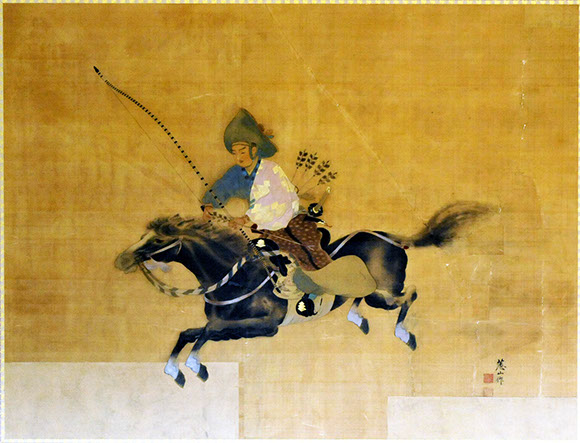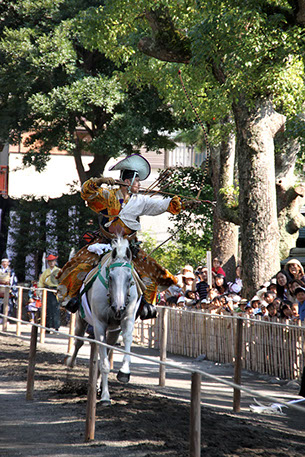The Ogasawara-ryū began when Ogasawara Nagakiyo, instructor to Minamoto-no-Yoritomo, founder of the Kamakura Shogunate, was invited to Kyoto in the year 1186. On the 15th of August in the following year (1187), the ritual of Yabusame* was conducted at the Tsurugaoka Hachimangū shrine (located in present day Kamakura city, Kanagawa Prefecture), and rituals of “Yumihajime*”, “Hōsha”, “Ōmato” and “Kasagake” were established as Shintō rituals for the warrior class of the time. Ngakiyo, along with the help of his father Kagami Tōmitsu and Ōe-no-Hiromoto, abbreviated many of the ceremonial rituals that were based off of old customs and practices of the court. Taking into account the time period that they lived in, Nagakiyo had established rituals that would befit the warrior class. An example of one such training which took place at the base of Mt. Fuji and its surrounding areas is known as “Fuji-no-maki-gari”, and was a way to teach archery to vassals who were missing their targets during hunting trips.
By the end of the Kamakura period, the Ogasawara family directly served emperor Go-daigo*, and along with being instructors of horse training and archery techniques, they were also known to have passed down the secret teachings of “Meigen” and “Yatakebi”. It is thanks to this that the Ogasawara family became famous as a household of “Mounted Archery”. Regulations of everyday actions, command of language, along with the equestrian commands, were consolidated into a discourse known as the “Shūshin-ron”. At presenting this discourse to the Emperor, an imperial edict was conferred to transform these teachings into a family code, and to this day and age, these teachings remain at the heart of the Ogasawara-ryū.
During the Muromachi period*, the Ogasawara family served the Ashikaga shogunate, and were active instructors to both shoguns Yoshimitsu and Yoshimasa. Thus, the Ogasawara family was able to perennate through the warring-states period to the Edo period. In the year 1604, the 17th generation head of the Ogasawara family, Ogasawara Tsunenao was invited by Tokugawa Ieyasu to Edo (present day Tokyo) to act as instructor, not only to his son Hidetada, but to various Daimyo* and Hatamoto* of the time.
The 20th generation head of the family, Ogasawara Sadamasa, had enacted a new type of Yabusame during the time of the eighth shogun Yoshimune, and was in charge of conducting matrimonial, Genpuku*, and birth rituals of the house of the shogun.
It is from this rich past of warrior martial techniques that the Ogasawara-ryū tradition of etiquette was developed. This development includes techniques of breathing, efficient use of muscles, and taking into account training and movement that promotes overall general health.
The Ogasawara-ryū is a school of etiquette, archery, and mounted archery that views etiquette as the building block of its techniques. Performing movements correctly one at a time, the movements become a part of the practitioner as they begin to correspond to the needs of space, time, and man. The movements of etiquette then flow to become the basic footwork required in archery. These in turn become the cursive movements of mounted archery that the practitioner learns within the Ogasawara-ryū tradition.
Starting with mounted archery, education of warriors during the Edo period encompassed the spear and sword, along with a multitude of weapons and techniques. As techniques were practiced and refined, the Samurai were able to gain an appreciation and mastery of the prepared state of mind. Whereas rules define victory and defeat within the world of sports and winning is of high importance, in mounted archery, the process of polishing one’s skill is far more important.
After the Meiji Restoration, the 28th generation head Ogasawara Kiyokane was appointed as vassal to the imperial household in the western part of the imperial palace, and in 1880, the Ogasawara School of etiquette, archery, and mounted archery was established and opened its’ doors to the public in Kanda, Tokyo. Henceforth, the Ogasawara household decreed that it is forbidden to make a livelihood from teaching etiquette, archery, and mounted archery. This precept was adopted to insure that techniques and teachings are not compromised, and so questionable means are not used for the sake of increasing attendance within students, which would ultimately only lead to the degradation and corruption of the warrior traditions. This is why, along with being the head of household, the late grandmaster made a living as a university professor, and I myself held the position of public officer.
In the Ogasawara family, there is a proverb that says: “by mastery, one becomes colorless, formless”. Though this appears a daunting task, I tend to think of it as merely cultivating daily practice, and seeing one's entire life as a journey of discipline.
*Yabusame: Name given to the Japanese ritual of mounted archery. *Yumihajime, Hōsha, Ōmato and Kasagake: Ogasawara-ryū archery rituals. *Emperor Go-daigo: (1288~1339 A.D.) 96th emperor of Japan, according to the traditional order of succession. *Muromachi period: Period of Japanese history approximately spanning from 1336 to 1573A.D. *Daimyo: Feudal lords, or territorial lords that ruled most of pre-modern Japan. *Hatamoto: Literally “under the banners” or “under the flag”, is a term used to refer to samurai in the direct service of the Tokugawa shogunate in feudal Japan. *Genpuku: Japanese coming of age historical ceremony held for males.
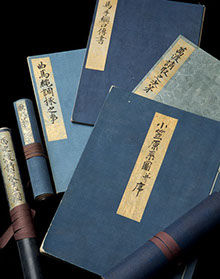
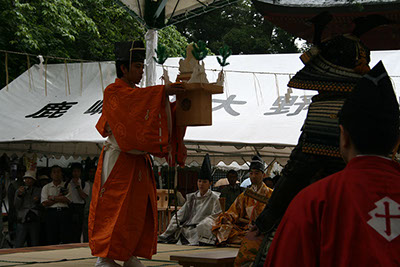

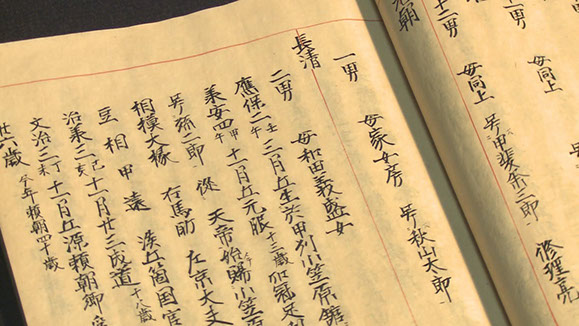
Whenever “etiquette” is mentioned within the Ogasawara-ryū, the first thing that comes to the minds of most people is the image of formality and rigidness. This though, is the number one mistake regarding the understanding of etiquette. Just mimicking form is meaningless. Why one conducts oneself in such a way, and why certain actions are conducted in a certain manner are two matters of utmost importance. Just bending your body to form a bow to another person has no meaning. The feeling that one has towards the other party is essential. When both parties bow to each other, it is important that the feeling of both parties reverberate to one another. It is this reverberation that gives life to the exchange between both parties, and gives life and meaning to the bow.
Conducting oneself in a correct manner requires daily practice. In the Ogasawara-ryū, daily actions such as sitting, standing, walking, turning, carrying objects, and bowing are practiced on a regular basis. Conducting such actions in a correct manner is what cultivates correct posture, which leads to correct, healthy, and practical movement. This is movement that eliminates futility, contains beauty, is effective, and natural.
Since olden times, it has been said in the Ogasawara-ryū that one must strengthen areas with few bones. Specifically, this refers to the neck and the lower back (lumbar vertebra). Strengthening these areas during etiquette practice is difficult unless a conscious effort is made. This is why within the teachings of the “Paneling of the Hakama”, it is said that one is to exert conscious effort with regards to the muscles of the lower back. Such is the insight of our predecessors. Taking into account various situations and training accordingly is the practice of etiquette. Conscious practice with repetition eventually leads to assimilation of the practiced motions into one’s own, and when the practitioner is able to perform these actions unconsciously, it is a sign that the motions of etiquette have at last become a living part of the practitioner.
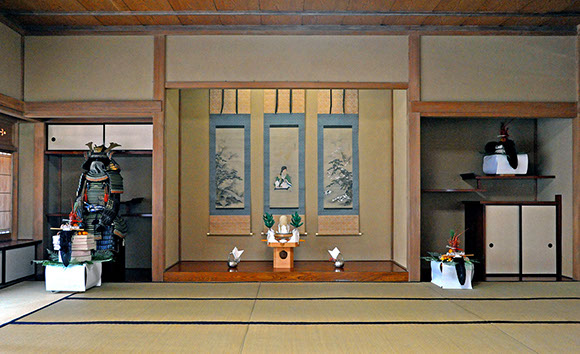
The Ogasawara-ryū archery techniques that are displayed within the training hall include “Komato-jarei”, “Tachi-jarei”, “I-jarei”, and “Maki-wara-jarei”. Ancient rites of archery within the Ogasawara-ryū include “Hiki-me” and “Momo-te”. Both are conducted as part of certain enshrinement rituals that include strict solemnity and dignity during, before, and after the rituals.
• Hiki-me: The various types of Hikime include: “Tanjō-hikime”, “Yagoshi-no-hiki-me”, and “Harai-no-hiki-me ”. Hiki-me refers to the arrowhead attached to the arrow, which resembles a toad (pronounced “Hiki-gaeru” in Japanese, bufo japonicus), and is made by whittling wood (pronounced “Hiki”) from a paulownia tree. Feathers from a hawk or crane are used for such arrows. The sound the arrow makes as it sails towards the target is believed to disperse ominous occurrences. Tanjō-hikime is conducted five months after pregnancy, on the day of “Obi-no-iwai”. The ritual is conducted to pray for the health and growth of the fetus. Yagoshi-no-hiki-me is a ritual conducted for the dispersal of ominous occurrences and illness, and is conducted to this day at Kyoto's Shimogamo Shrine during the “Aoi-matsuri” (Hollyhock festival) on the fifth day of May. Harai-no-hiki-me is used as a prayer during rites of exorcism and is sometimes known as “Yo-hikime”. This type of Hiki-me also appears in the famous “Tale of Heike”, and is still considered an offering in different parts of Japan to this day.
• Ōmato-shiki: According to the “Nihon-shoki”, an ancient document concerning the history of Japan, around fifteen hundred years ago, emperor Seinei decreed that archery be conducted. From this, Ōmato-shiki was carried out at the Butoku-den and the Yumi-ba-den within the imperial court. Warriors began the ritual of Ōmato-shiki after Minamoto no Yoritomo had started the archery ritual. Ever since, the ritual has been conducted every year on the fourth day of the new year, according to the “Azuma-kagami”. Although this ritual had declined at one point in time, it was revived in the Edo period under the direction of the eighth Tokugawa shogun Yoshimune through Ogasawara Heibei Tsuneharu, and was carried out on the 17th of January in the Fukiage garden. To this day, this ritual is conducted with the utmost of solemnity in the Meiji Shrine's “Hagi-no-Oniwa”.
• Momote-shiki: Ten archers, all armed with twenty arrows each participate in this ritual, which is conducted as a sort of prayer. Nowadays, the ritual is abbreviated by having more archers participate with each only shooting two arrows. Arrows are shot in a constant rhythm that resembles rain falling on the targets.
• Kusajishi-shiki: Kusajishi-shiki was started because while hunting at the foot of Mount Fuji, Minamoto no Yoritomo’party had been missing it’s mark, so retainers gathered grass and formed it in the shape of a deer, shooting it from the back of a horse. What was originally a sport was formally organized and had a set of rules determined for it during the Edo period. Every year during the national holiday of Physical Education in Japan, the ancient ritual of Kusajishi-shiki is conducted on the grounds of Yasukuni Shrine.
• San-san-kute-basami-shiki: This solemn ritual is conducted on the fourth day after the New Year, and serves as a means that unites literary and martial paths, and celebrates peace and tranquility over the land. Literary arts form the “outer” part of the ritual, while martial arts form the “inner” part.
Besides the rituals listed above, there exist the rituals of “Buri-buri-shiki”, “Maru-mono”, and “Hasami-mono” (shells, leaves, paper, shoes, and a folding fan, all used as targets).
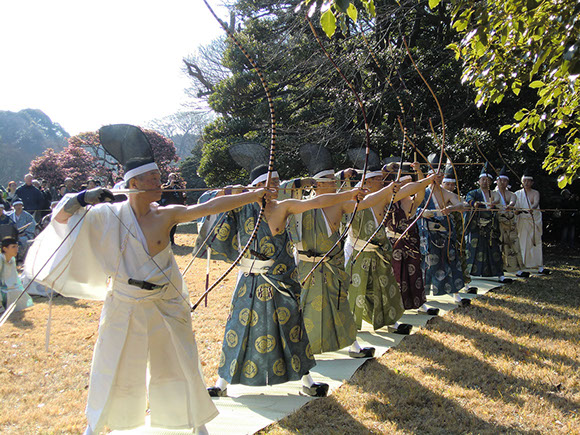

The Ogasawara-ryū mounted archery disciplines include “Yabusame”, “Kasa-gake”, and “Inu-ou-mono”. Inu-ou-mono, along with Kusajishi-shiki is art turned sport, with rules dictating the match outcome. During the twelfth year of Meiji (1879 A.D.), Inu-ou-mono was performed at Ueno Park during Ulysses S. Grant's visit to Japan after his presidency, with the presence of Emperor Meiji. This though was one of the last times Inu-ou-mono was performed, and the practice was abandoned in the name of animal protection. Nowadays, only the disciplines Yabusame and Kasa-gake remain.
• Kasa-gake: There exist two forms of Kasa-gake, “En-kasa-gake” and “Ko-kasa-gake”. Ko-kasa-gake is a form of practice for hunting pheasants or birds of the like, and consists of shooting at a target that is 4 Sun (12.1cm; 4.8in) wide, placed on a pole that is 1 Shaku and 2 Sun (36.4cm; 1ft 2.3in) above the ground, located 1 Shaku (30.3cm; 11.9in) apart from the track. This requires a high level of skill to hit from horseback. “En-kasa-gake” has targets that are 1 Shaku and 8 Sun (54.5cm; 1ft 9.5in) wide placed at a distance of 65.7 Shaku (19.9m; 21.8yds). Although the targets are larger, because of the longer distance, a high level of skill and accuracy are required. These days, Ko-kasa-gake has been reformed to have longer distances and larger targets, while En-kasa-gake has been reformed to have shorter distances. This essentially makes Yabusame the last unchanged discipline since olden times.
• Yabusame: Three targets are placed within a track 2 Chō in length (approx. 250m; 273yds) and are shot from horseback. Mounted archers dress in Kamakura period hunting attire, consisting of “Yoroi-hitatare” or “Sui-kan”, “Ayai-gasa”*, “Igote”*, “Tachi”, “Ebira”*, and arrows with Kari-mata* affixed as arrow heads. Along with this form of Yabusame, a form that was performed during the time of the eighth Tokugawa shogun Yoshimune in which Ogasawara Tsuneharu only donned an “Idōgi”*, hakama, tabi, “Kisha-gasa”*, and an Igote. Using arrows with rounded wooden arrow heads, this lightweight form of Yabusame is known as “Kisha-hasami-mono”. Unlike olden times, horses these days are bred to be faster, and so there are voices that suggest the equipment used be updated to match the times.
*Ayai-gasa: A hat made of straw. *Igote: Archer's arm guard. *Ebira: Quiver. *Kari-mata: Metallic arrow head with a crescent like shaped tip. *Idōgi: A type of Kimono. *Kisha-gasa: Archer's hat.
